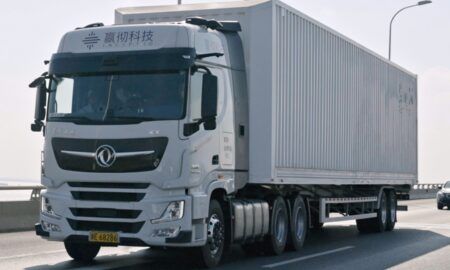Connected and automated vehicle (CAV) technology company Peloton Technology, which specializes in truck platooning systems, is participating in a US Department of Energy-sponsored program to develop the next generation of automated truck convoy systems.
The Next-Generation Energy Technologies for Connected and Automated On-Road Vehicles (NEXTCAR) program is sponsored by the US DOE’s Advanced Research Projects Agency-Energy (ARPA-E). The project will apply next-generation truck platooning technology and concepts for smart, cloud-connected powertrains to achieve 20% fuel savings for tractor-trailers.
Led by Purdue University, Peloton’s NEXTCAR project team will use the company’s current system and higher-automation platooning technology under development, advanced powertrain systems from Cummins, steering controls from ZF TRW, and state-of-the-art trucks from Peterbilt, together with contributions from the University of Arizona, and the National Renewable Energy Laboratory (NREL). Peloton and its NEXTCAR partners expect to launch the three-year project in March 2017. The team will receive a total of US$5m from ARPA-E and will provide additional cost share funding.
The partners will develop, integrate, and demonstrate a set of co-optimized powertrain and automated driving controls to improve the fuel efficiency of tractor-trailers. By combining novel algorithms, look-ahead data, and vehicle-to-vehicle (V2V) and vehicle-to-cloud (V2C) connectivity, the team aims to reduce the fuel use of a baseline Class 8 Peterbilt 579 truck by 20% in real-world driving conditions. The new controls require minimal hardware changes and can be programmed into electronic control units (ECUs) that are already on the trucks, allowing innovations from the project to be commercialized at low cost.
Peloton’s current flagship platooning system, which will reach commercial trucking fleets in 2017, creates a wireless link between the automated throttle and brake control systems on multiple trucks to synchronize their speeds and maintain a safe following distance. For NEXTCAR, Peloton aims to increase fuel savings at highway speeds from an existing baseline average of 7% across two trucks, to 20% with the use of connected powertrains. The gains from the NEXTCAR project will require several technology advancements, including the development of powertrain set points optimized for when trucks are operating in platooning mode, and the integration of steering control that will raise the system from a SAE Level 1 to Level 2 automated driving classification.
Peloton will also meet the connectivity requirements of powertrain innovations, including over-the-air engine recalibrations, and distributed computing between trucks and the cloud. This will build on its experience in developing a cloud-based Network Operations Center to manage vehicles equipped with automated driving systems, including its flagship truck platooning system, which employs DSRC, cellular LTE and wi-fi to connect vehicles to each other and to the cloud.
“Our objective is to tap into fuel savings that can only be attained by managing the powertrain precisely for the road ahead, and for the specific configuration of the trucks,” said Michael Palmer, Peloton’s director of research. “Cloud connectivity provides information about the road ahead, and the trucks exchange data about their estimated mass and powertrain capabilities. This helps us maintain smooth, efficient platooning through grades and rolling hills.”




